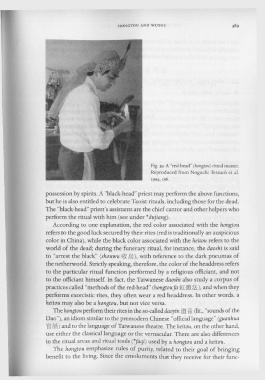Page 529 - The Encyclopedia of Taoism v1_A-L
P. 529
HONGTOU AND WUTOU
Fig. 39. A "red-head" (hongtou) ritual master.
Reproduced from Noguchi Tetsuro et al.
1994,156.
possession by spirits. A 'black-head" priest may perform the above functions,
but he is also entitled to celebrate Taoist rituals, including those for the dead.
The 'black-head" priest's assistants are the chief cantor and other helpers who
perform the ritual with him (see under *dujiang).
According to one explanation, the red color associated with the hongtou
refers to the good luck secured by their rites (red is traditionally an auspicious
color in China), while the black color associated with the heitou refers to the
world of the dead; during the funerary ritual, for instance, the daoshi is said
to "arrest the black" (shouwu 4)(: ,~), with reference to the dark pneumas of
the netherworld. Strictly speaking, therefore, the col or of the headdress refers
to the particular ritual function performed by a religious officiant, and not
to the officiant himself. In fact, the Taiwanese daoshi also study a corpus of
practices called "methods of the red-head" (hongtou fa tIT]!]! 1!), and when they
performs exorcistic rites, they often wear a red headdress. In other words, a
heitou may also be a hongtou, but not vice versa.
The hongtou perform their rites in the so-called daoyin i@1f (lit., "sounds of the
Oao"), an idiom similar to the premodern Chinese "official language" (guanhua
1§ ~j5) and to the language of Taiwanese theatre. The heitou, on the other hand,
use either the classical language or the vernacular. There are also differences
in the ritual areas and ritual tools (*faqi) used by a hongtou and a heitou.
The hongtou emphasize rules of purity, related to their goal of bringing
benefit to the living. Since the emoluments that they receive for their func-

